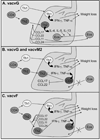Overcoming T cell-mediated immunopathology to achieve safe RSV vaccination
- PMID: 19057653
- PMCID: PMC2593094
- DOI: 10.2217/17460794.3.5.445
Overcoming T cell-mediated immunopathology to achieve safe RSV vaccination
Abstract
Respiratory syncytial virus (RSV) is the leading cause of lower respiratory tract disease in young children. Premature infants, immunocompromised individuals, and the elderly exhibit an increased risk for the development of severe disease after RSV infection. Currently, there is not a safe and effective RSV vaccine available, in part due to our incomplete understanding of how severe immunopathology was induced following RSV infection of children previously immunized with a formalin-inactivated RSV vaccine. Much of our current understanding of RSV vaccine-enhanced disease can be attributed to the establishment of multiple mouse models of RSV vaccination. Studies analyzing the RSV-specific immune response in mice have clearly demonstrated that both CD4 and CD8 memory T cells contribute to RSV-induced immunopathology. In this review we will focus our discussion on data generated from the mouse models of RSV immunization that have advanced our understanding of how virus-specific T cells mediate immunopathology and RSV vaccine-enhanced disease.
Figures

References
-
- Collins PL, Chanock RM, R MB. In: Fields Virology. Fourth ed. Knipe DM, Howley PM, editors. Vol. 1. Philadelphia, PA: Lippincott Williams & Wilkins; 2001. pp. 1443–1485.
-
- Simoes EA. Respiratory syncytial virus infection. Lancet. 1999;354:847–852. - PubMed
-
- Johnson KM, Bloom HH, Mufson MA, Chanock RM. Natural reinfection of adults by respiratory syncytial virus. Possible relation to mild upper respiratory disease. N Engl J Med. 1962;267:68–72. - PubMed
-
- Hall CB, Walsh EE, Long CE, Schnabel KC. Immunity to and frequency of reinfection with respiratory syncytial virus. J Infect Dis. 1991;163:693–698. - PubMed
-
- Beem M. Repeated infections with respiratory syncytial virus. J Immunol. 1967;98:1115–1122. - PubMed
Grants and funding
LinkOut - more resources
Full Text Sources
Other Literature Sources
Research Materials
